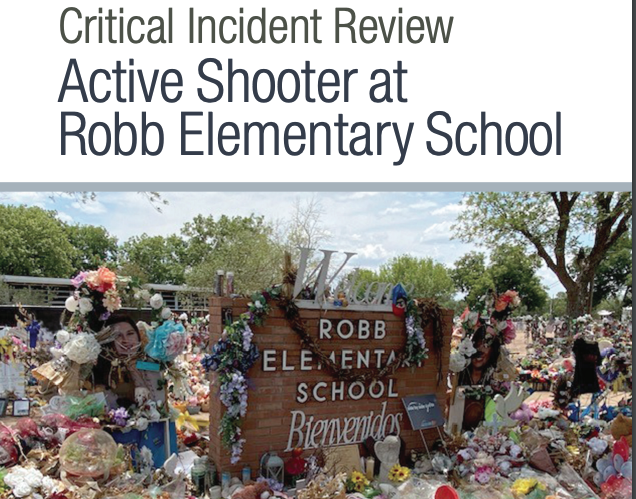
That word summarizes and permeates the entirety of the 610 page PDF published by the Department of Justice.
Contained within is a cold, sterile, and ruthless recrimination of the complex and catastrophic failure of the Uvalde Police response to the Robb Elementary School Mass Shooting.
The one sentence summary is this: Armed responders, able to push and engage the shooter, were on site for 77 minutes before entering the classroom and killing the shooter. This behavior is in direct conflict with all modern active shooter training and policy, it is something we’ve known since Columbine.
Or in the words of the summary,
The most significant failure was that responding officers should have immediately recognized the incident as an active shooter situation, using the resources and equipment that were sufficient to push forward immediately and continuously toward the threat until entry was made into classrooms 111/112 and the threat was eliminated. Since the tragic shooting at Columbine High School in 1999, a fundamental precept in active shooter response and the generally accepted practice is that the first priority must be to immediately neutralize the subject; everything else, including officer safety, is subordinate to that objective. Accordingly, when a subject has already shot numerous victims and is in a room with additional victims, efforts first must be dedicated to making entry into the room, stopping the subject, and rendering aid to victims. These efforts must be undertaken regardless of the equipment and personnel available to those first on the scene.
Overview of CIR Factual Observations
At 11:33 a.m. on the morning of May 24, 2022, the subject entered Robb Elementary School equipped with a high-powered AR-15 rifle. He immediately started shooting and within a minute entered classrooms 111 and 112, which were connected via an interior door.
Within 3 minutes of the subject’s entry into the school, 11 law enforcement officers from the Uvalde Consolidated Independent School District (UCISD) and Uvalde Police Departments (UPD), including supervisors, arrived inside the school. Hearing continued gunfire, five of the responding first on scene (FOS) law enforcement ran toward classrooms 111/112. The other six FOS did not advance down the hallway, including UPD Acting Chief Mariano Pargas, who was in the best position to start taking command and control, and to start coordinating with approaching personnel. One of the officers said to “line up to make entry” and within seconds shots were fired from inside one of the rooms. Two officers were hit with shrapnel, and all responders retreated to positions of cover.
After three attempts to approach the classrooms, the focus of the responders shifted from entering classrooms 111/112 and stopping the shooting to evacuating other classrooms, attempting to negotiate with the subject, and requesting additional responders and equipment. With this shift from an active shooter to a barricaded subject approach, some responders repeatedly described the subject over the radio as “barricaded” or “contained.” Yet within four minutes from FOS arrival, 911 dispatch confirmed that class was in session and reported that they had received calls from victims.
Chief Pete Arredondo of the UCISD Police Department (UCISD PD) directed officers at several points to delay making entry into classrooms 111/112 in favor of searching for keys and clearing other classrooms. Occupants of other classrooms were at risk of further injury as a result of the high-powered nature of the shooter’s AR-15 style rifle and from possible crossfire once classrooms 111 and 112 were entered. At several points, UCISD PD Chief Arredondo also attempted to negotiate with the subject. Others called out over the radio for additional resources and indicated that they were waiting for a tactical team to arrive, such as Uvalde special weapons and tactics (SWAT), the Texas Department of Public Safety (TXDPS), and the U.S. Border Patrol Tactical Unit (BORTAC). Chief Arredondo, who became the de facto on-scene commander, was without his radios, having discarded them during his arrival, and communicated to others either verbally or via cell phone throughout the response.
Over the course of the incident, overwhelming numbers of law enforcement personnel from different agencies self-deployed to the school. Leadership on scene, however, had not established command and control, to include an incident command post (ICP), staging area, or clear perimeter around the hallway or the school. Thus, arriving personnel did not receive accurate updates on the situation or direction for how to support the response efforts. Many arriving officers—based on inaccurate information on the scene and shared over the radio or from observing the lack of urgency toward entering classrooms 111/112—incorrectly believed that the subject had already been killed or that UCISD PD Chief Arredondo was in the room with the subject. As leaders from additional law enforcement agencies arrived, including Uvalde County Sheriff Ruben Nolasco, the lack of clear communication and command structure made coordination difficult. Emergency medical responders faced similar challenges as they deployed. They struggled to identify who was in charge, and ambulances encountered streets blocked by law enforcement vehicles.
Concerned families were also arriving at the school. They likewise had difficulty obtaining information about their loved ones’ status. Incorrect and conflicting information was also being shared on social media with the UCISD posting that all students and staff were safe in the building and later posting messages about reunification that conflicted with the UPD posts.
At 12:21 p.m., 48 minutes after the subject entered the school, the subject fired four additional shots inside classrooms 111/112. Officers moved forward into formation outside the classroom doors but did not make entry. Instead, presuming the classroom doors were locked, the officers tested a set of keys on the door of a janitor’s closet next to room 112. When the keys did not work, the responders began searching for additional keys and breaching tools. UCISD PD Chief Arredondo continued to attempt to communicate with the subject, while UPD Acting Chief Pargas continued to provide no direction, command, or control to personnel.
After another 15 minutes, officers found a second set of keys and used them to successfully open the janitor’s closet. With working keys in hand, the officers then waited to determine whether a sniper and a drone could obtain sight of and eliminate the subject through the window. Those efforts were unsuccessful.
At 12:48 p.m., 27 minutes after hearing multiple gunshots inside classrooms 111 and 112, and 75 minutes after first responders first entered Robb Elementary, officers opened the door to room 111. A team composed of BORTAC members, a member of the U.S. Border Patrol Search, Trauma, and Rescue Unit (BORSTAR), and deputies from two local sheriffs’ offices entered the rooms, and officers killed the subject when he emerged shooting from a closet. The subject was killed at approximately 12:50 p.m., 77 minutes after the first officers entered the school and after 45 rounds were fired by the shooter in the presence of officers.
Aftermath
I was shocked to read Mariano Pargas, the initial incident commander (or who should have been), is currently fighting to get his dismissal and discharge status from Law Enforcement changed to “honorable” instead of “general”. I know there are a lot of ‘strong feelings’, to be polite, in responder circles about Paragas and Arredando. A General Discharge is very kind.
I do not know how it works specifically within law enforcement, but a general discharge in the military indicates problems. Those problems are usually within how their job was performed, and the handling of Robb Elementary would seem to qualify, but not anything directly criminal. Stupidity, incompetence, and cowardice are not criminally in the same categories as assault or homicide. Where those items are crimes at all is rare.
Law enforcement remains removed from liability for not protecting you. It remains an implied duty and not a legally binding one that they can be held accountable for failing at.
That is its own slippery slope. Trying to weigh the officer and agency best efforts, and whether or not they rate as good enough or too little and negligent, will be a nightmare. It is one of the reasons that it remains a non-liable act for cops to not protect you.
Where they failed
Within 3 minutes of the subject’s entry into the school, 11 law enforcement officers from the Uvalde Consolidated Independent School District (UCISD) and Uvalde Police Departments (UPD), including supervisors, arrived inside the school. Hearing continued gunfire, five of the responding first on scene (FOS) law enforcement ran toward classrooms 111/112. The other six FOS did not advance down the hallway, including UPD Acting Chief Mariano Pargas, who was in the best position to start taking command and control, and to start coordinating with approaching personnel. One of the officers said to “line up to make entry” and within seconds shots were fired from inside one of the rooms. Two officers were hit with shrapnel, and all responders retreated to positions of cover.
Here, in these opening minutes. Here is where they failed and never recovered. Instead of pushing with their 5:1 odds to take the shooter out, they backed away and never meaningfully reengaged. One or two officers, like the acting chief, could be responsible for briefing and placing responders as they rolled in but they didn’t. Instead we have famous now infamous footage of officers waiting, doing little to nothing, and stopping the officers who did want to move in and end the event… for 77 minutes.
Next?
This is the Federal report, the local investigations may include more direct consequences for individuals in charge. We will see.



